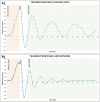Estimation of natural frequency for nonlinear mechanical retention of printed circuit board
- PMID: 40419609
- PMCID: PMC12106839
- DOI: 10.1038/s41598-025-03353-5
Estimation of natural frequency for nonlinear mechanical retention of printed circuit board
Abstract
Vibrational performance for a structure, in majority of the cases, is estimated/ predicted using frequency domain solvers. Linearity and Time-invariance are imposed onto the structure for solving in frequency domain. In this research, vibrational performance of two mechanical mounting methods for a hot-swappable electronic PCB have been analyzed and experimented upon, in the range of 7 to 300 Hz. Natural frequencies were first estimated using Linear Modal Analysis and the response up to 500 Hz was obtained through Harmonic analysis. The resonance was predicted at 440.8 Hz for both the mounting methods. Experiments were conducted on both the setups to determine the natural frequencies through a sinusoidal sweep. Resonance was observed at 110 Hz and 193 Hz for Setup-I & II, respectively. These large deviations led to investigation on factors which played a major role in shifting the frequencies, arising out of both mounting methods. Limitations of linear modal analysis were highlighted. A method (computational + FFT) is devised for estimating the natural frequencies in which time domain response was coupled with Fast Fourier Transform (FFT). Validation against the testing showed that the suggested method predicted the non-linear natural frequencies with a significantly improved accuracy (Nominal deviation < 2%) for both the setups.
Keywords: Clearance effects; FFT; Natural frequency estimation; Non-linearity; Spring finger retainer; Transient response.
© 2025. The Author(s).
Conflict of interest statement
Declaration. Competing interests: The authors declare that they have no known competing financial interests or personal relationships that could have appeared to influence the work reported in this paper.
Figures













References
-
- Murthy Shankara, H. M., Niranjan, R. & Hegde Ramakrishna, N. “Electronic cooling”, Energy systems design for low-power Computing (IGI Global, 2023). 10.4018/978-1-6684-4974-5.ch006.
-
- Turkosz Daniel, J., thesis in acoustics ‘Transient structural analyses using frequency-domain computations and fourier transform techniques’. The Pennsylvania State University, 2010.
-
- Joint services specification on environmental test methods for electronic and electrical equipment (JSS55555: 2012, Revision No. 3), Ministry of Defence – Government of India.
-
- Yang, B. “Theory of vibration| fundamentals” Encyclopedia of Vibration (Elsevier, 2001). 10.1006/rwvb.2001.0112.
-
- Chandravanshi, M. & Mukhopadhyay, A. Modal analysis of structural vibration. Proceedings of the International Mechanical Engineering Congress and Exposition (IMECE 2013). San Diego, CA. (2013).
LinkOut - more resources
Full Text Sources

